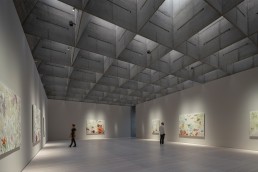
Liljevalchs Konsthall, Stockholm, Sweden
Complementing the brutalist architecture of Stockholm’s Liljevalchs Konstall, luminaires from Erco offer a flexible solution to highlight the artworks on display.
For more than 100 years, Liljevalchs Konsthall has been the leading exhibition venue for contemporary art in Stockholm. Its spring salon has a fixed place in the cultural calendar of the metropolis, and the building, designed by architect Carl Bergsten in 1916, is considered a breakthrough work of modern architecture in Sweden.
The standards were correspondingly high when, after a competition, Gert Wingårdh’s architectural office was commissioned to build an extension in 2013: State-of-the-art presentation possibilities, security and air-conditioning contributed to making it possible to play a confident role in the worldwide exchange of art exhibitions.
Wingårdh is one of Sweden’s most successful architects. Through his TV presence in the series “Husdrömmar” about private builders, the 70-year-old is also known to the wider public. For the Konsthall, he designed a compact, concrete cuboid in close collaboration with the glass artist Ingegerd Råman. Like a jagged crown, the roof features 166 chimney-like light shafts on a square grid. Only a few window openings break through the façade. This is structured by 6,860 round glass elements that are reminiscent of clear bottle bottoms and glitter in the flat Nordic light. The ceiling openings create a soft, modulated and atmospheric light in the room. The skylights create optimal presentation conditions for both small and large-format exhibits. Erco’s Eclipse spotlights form the Konsthall’s new luminaire pool. With their interchangeable lenses, accessories, and on-board dimming, they can be flexibly adapted to a wide variety of lighting tasks. The carefully calculated, upward-tapered shape of the light wells screens out direct sunlight. Track segments in flush recessed profiles carry Parscan spotlights as basic lighting and Eclipse spotlights to set the stage for the exhibitions.
The feeling of space in the daylight halls of different heights under the freely spanned concrete grid is spectacular. The sophisticated ceiling geometry controls and diffuses the daylight. Tracks set flush into the sides of the light shafts carry spotlights, floodlights or wallwashers to illuminate the exhibits. In this way, the building manages the balancing act of providing a neutral background for the art and at the same time always remaining perceptible and present.



